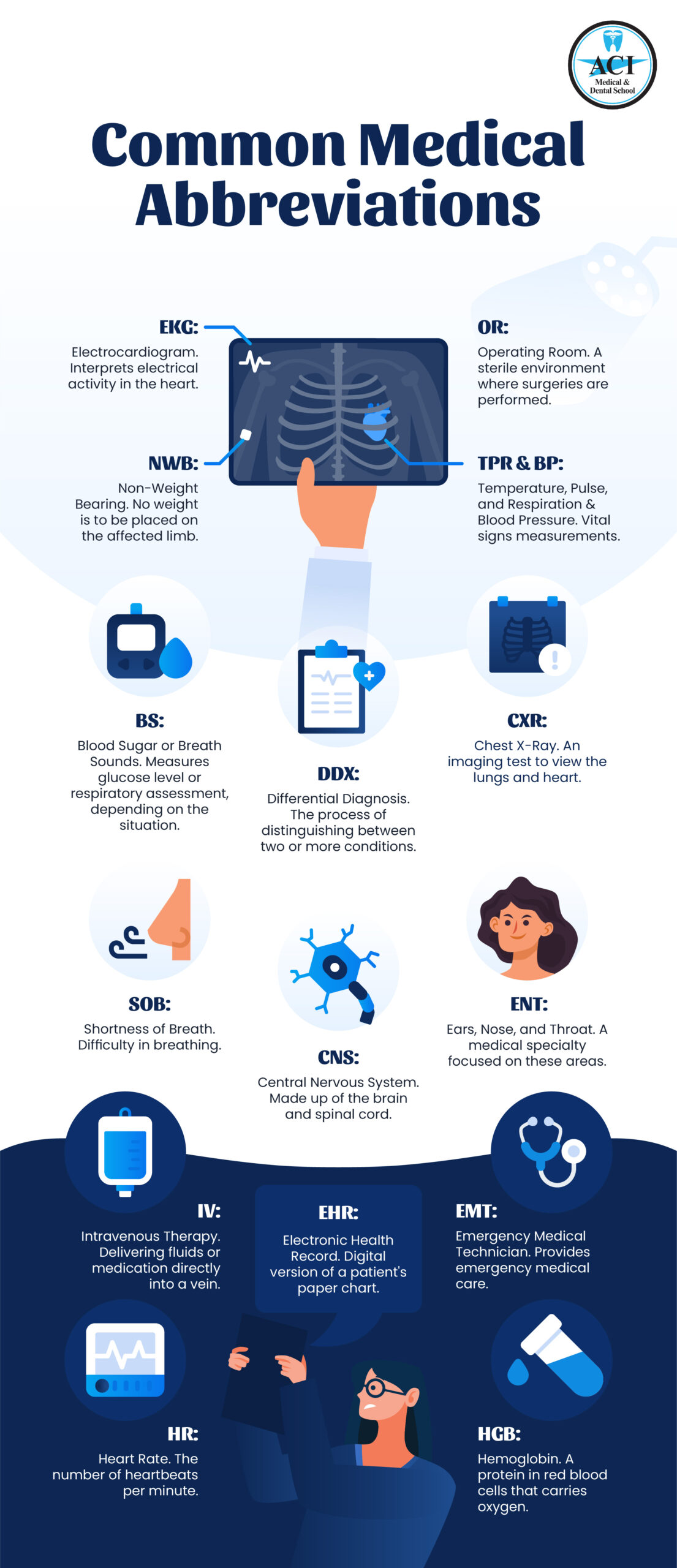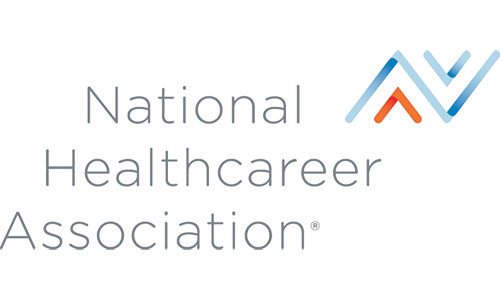Here at ACI Medical & Dental School, we offer courses and training designed to prepare students for successful careers in the medical and dental fields. Because these professions use many abbreviations that appear frequently in day-to-day work, we created this guide for students training to become Medical Assistants, Phlebotomists, or Dental Assistants. It covers common medical abbreviations and what they mean for students entering these careers:
15 Common Medical Abbreviations And Their Meanings
EKG: EKG is an abbreviation familiar to many of our EKG Technician students and to those studying to become a CCMA with Phlebotomy, EKG, and Patient Care Tech. EKG stands for Electrocardiogram. While the word “cardiogram” starts with a “C,” the “K” in EKG comes from the Greek word for heart, kardia. An EKG records the heart’s electrical activity by placing electrodes on various areas of the body. It’s a noninvasive test—meaning it does not require surgery—and is one of the most important procedures for detecting heart abnormalities, including heart attacks.
TPR & BP: These abbreviations are used frequently in medical settings, including for Medical and Dental Assistants, as well as Medical Administrative Assistants. TPR stands for Temperature, Pulse, and Respiration, all of which give a quick overview of a patient’s overall health. Even during a routine physical, these measurements can reveal important information. BP stands for blood pressure, and it is usually recorded alongside TPR. Together, TPR and BP may be grouped under VS, which stands for Vital Signs.
NWB: This abbreviation, which stands for Non-Weight Bearing, is common in physical therapy and rehabilitation settings. For Medical Assistants working with patients recovering from injuries or using crutches, NWB is an important note indicating that no weight should be placed on the affected limb.
OR: For those who are working in the medical field, OR stands for Operating Room, not the grammatical conjunction. The OR is where invasive surgical procedures are performed, and the term appears frequently in records for patients needing major medical care.
BS: BS has a few different meanings in the medical profession, none of which are the same as the casual slang. BS may stand for Blood Sugar or Breath Sounds, depending on the patient’s condition. For patients with diabetes or dietary concerns, BS usually means blood sugar, although BG (Blood Glucose) is often used instead to avoid confusion. For patients with respiratory issues such as COPD or asthma, BS refers to breath sounds. Understanding the patient’s medical history is key to knowing which meaning applies.
DDX: Differential Diagnosis. DDX refers to a method used to identify the cause of a patient’s symptoms when more than one possibility exists. The medical team collects information to rule out conditions that are not the cause, narrowing down the diagnosis. DDX can also refer to each possible condition under consideration.
SOB: SOB stands for Shortness of Breath, also called dyspnea. This symptom—an unusual or uncomfortable awareness of breathing—can be linked to many conditions, including heart failure, asthma, and lung disease.
CNS: The Central Nervous System, or CNS, includes the brain and spinal cord, which control activities in all other parts of the body. Diseases affecting the CNS include Parkinson’s disease, Alzheimer’s disease, and amyotrophic lateral sclerosis (ALS).
CXR: CXR stands for Chest X-Ray, a test that uses radiation to create images of the lungs. CXRs are essential for diagnosing conditions such as pneumonia and congestive heart failure, and they can help provide a complete picture of a patient’s overall health. While our dental radiology technician program uses X-ray technology for dental imaging, the principles are the same.
ENT: ENT stands for Ears, Nose, and Throat, and refers to otolaryngology, the medical specialty focused on these areas. It is one of the oldest medical specialties, and many doctor visits are related to ENT conditions.
EHR: EHR stands for Electronic Health Record. An EHR makes a patient’s medical information accessible to multiple healthcare providers across networks. It can include medical history, medications, billing details, immunizations, and more. EHRs help keep patient information accurate and up to date. Students in our Medical Billing and Coding program work extensively with EHR systems and learn how to manage them efficiently.
HR (Heart Rate): Heart rate is the number of times the heart beats per minute, measured in bpm (beats per minute). A normal resting heart rate for adults is 60–100 bpm. Rates outside this range may indicate health issues such as cardiovascular disease, hypothyroidism, or anemia. Monitoring heart rate is a vital part of patient care.
EMT: EMT stands for Emergency Medical Technician, a professional trained to respond to urgent medical situations. There are four levels of EMT certification, each suited for different emergencies. EMTs are employed by organizations such as fire and police departments and are crucial in saving lives during critical situations. The swift attention from EMTs has saved countless lives over the years, and continues to play an important role in the medical community.
IV: IV stands for Intravenous Therapy, a method of delivering fluids directly into a patient’s veins. Often conducted by nurses, this can be used for treatments such as chemotherapy, blood transfusions, and hydration. IVs are one of the most efficient ways to introduce vital substances into the body.
HGB: Hgb stands for hemoglobin, a protein in red blood cells that carries oxygen throughout the body. Abnormal hemoglobin levels can indicate health problems. Low hemoglobin levels may be linked to kidney failure, sickle-cell disease, or nutritional deficiencies, while high levels may be associated with lung disease, dehydration, or polycythemia rubra vera.









